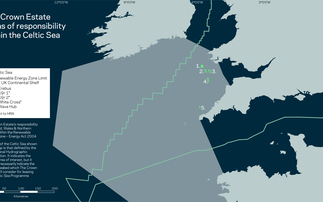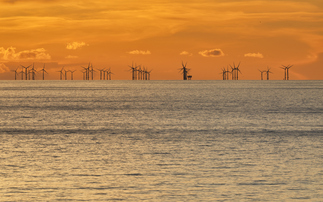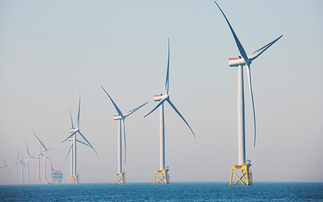The shockingly impressive cost reductions achieved by the offshore industry should send shock waves far beyond the energy sector
A decade ago, when BusinessGreen launched, there were just 172 offshore wind turbines under construction or development in UK waters spread across a handful of sites. Each turbine delivered power at an eye-watering cost well in excess of £150/MWh. The fledgling industry was excited about its prospects, but was reluctant to make any bold pledges about future costs, repeatedly warning that engineering in the high seas is notoriously difficult.
Four years ago I chaired an industry panel where a senior offshore wind executive urged the government to be flexible with its mooted target requiring developers to deliver power at a cost of less than £100/MWh by 2020, arguing giant next generation turbines and floating foundations were still years away.
Four months ago, a senior industry source quietly suggested developers would smash expectations at this autumn's clean energy auction, comfortably undercutting the £92.50/MWh contract awarded to Hinkley Point. Around £70/MWh might be possible, they said, adding that some 'mad' people were hoping for somewhere around the £65/MWh mark.
Today the results of the auction came in, and it turns out all the experts were wrong. An industry that only a decade ago was a costly, marginal concern, which often felt like an engineers' pipe dream beset by countless technical and planning problems, promised to deliver clean power at a price of just £57.50/MWh. Mammoth turbines erected miles out to sea will within five years be delivering power at a cost almost half the level of projects that were given the go-ahead just two years ago. These new sites will undercut the Hinkley Point nuclear project, and, crucially, will be cost competitive with new gas-fired power plants.
It is hard to overstate the significance of this achievement. It has the potential to transform the energy industry, revitalise the UK's industrial strategy, and break the depressingly deadlocked debate over the importance of climate action. To borrow a phrase, this changes everything.
The most immediate impact will be felt within an energy sector that has just seen any remaining vestiges of doubt about the viability of large scale renewables blown out of the water. The promise of offshore wind power at a cost that had previously been thought almost impossible is exciting enough, but the real cause for optimism is to be found in the fact the industry is nowhere near the end of its cost reduction curve.
It remains difficult to see how new nuclear and gas plants can deliver significant further cost reductions in the medium term, but offshore wind developers are confident even larger turbines with up to 15MW of capacity are possible, while innovative new floating turbines, smart grid technologies, and simple economies of scale promise to cut costs still further over the next decade.
Inevitably, in the midst of this well-founded optimism it is important to sound a note or two of caution. The last time an energy contract auction threw up some surprising results the most aggressive bids came from solar farm projects that never materialised. Today's successful bids were made by experienced offshore wind developers who fully understand how CfDs work and appreciate the significance of the competitive bids they have lodged. The industry's excellent track record suggests it is highly likely the projects will be delivered on time and on budget. However, the legal battle that continues to dog the 450MW Neart na Gaoithe project highlights how development risks do exist.
Similarly, Brexit could throw a spanner in the works for an industry that is reliant on international supply chains and is hoping to sell a large chunk of its power to neighbouring countries. And industry insiders are right to warn that in the near-term the offshore wind sector faces a development hiatus, thanks to the repeated delays to this latest auction.
More important still, offshore wind's cost reduction trajectory presents some potential risks for the UK's wider decarbonisation efforts. The longer term prospects for the clean energy sector rest on the results of this autumn's promised Treasury announcement on the future of the government's funding mechanism - the so-called Levy Control Framework. Faced with perennial calls to axe green levies there will be some ministers who will be tempted to cash in the windfall provided by low cost offshore wind and trim overall levels of support for clean energy beyond 2020. It is, of course, entirely right that the cost reductions delivered by renewables benefit billpayers, but the government has to be careful to ensure sufficient support continues to deliver on emission reduction and energy security goals.
Similarly, Ministers could be tempted to double down on the offshore wind industry's success by diverting even more of the available funding pot towards new offshore projects, side-lining other technologies in the process. The government is today facing calls from across the political spectrum to do precisely this, with environmental campaigners urging Ministers to scrap the more costly Hinkley Point and opponents of Swansea Bay's proposed tidal lagoon directing the same argument at marine power.
But betting the farm on offshore wind would be a mistake. For a start if the cost reduction achieved by offshore wind projects over the past two years is remarkable the savings that could be delivered by onshore wind and solar farms would be similarly impressive if only the government provided developers with a route to market.
Secondly, forcing earlier stage clean energy projects, such as marine, geothermal, or small modular reactor developments, to compete with offshore wind risks choking off technologies that are currently expensive but have the potential to emulate offshore wind's success and bring down costs over time.
Finally, those opponents of renewables who present the fact that the wind does not always blow as the kind of mind-blowing revelation only visible to those blessed with their Galileo-like intellect may be guilty of wilfully ignoring the fact integration costs for variable renewables have been shown to be relatively low - circa £10-£20/MWh, meaning today's offshore wind projects should still undercut Hinkley Point. But they also have a point of sorts. The UK needs a clean energy mix and while we should now expect offshore wind to play a more dominant role it does not necessarily follow that we no longer need other forms of renewables, new nuclear, carbon capture and storage, and drastic improvements in energy efficiency. Equally, the prospect of increased reliance on variable renewables means the case for the rapid deployment of smart grid and energy storage technologies becomes even more compelling.
Thankfully, the government is well aware of these inter-locking challenges and, to borrow football manager parlance, they are all nice problems to have. Offshore wind's staggering performance promises to cut the overall cost of decarbonisation, create tens of thousands of new jobs, reduce energy bills for consumers and businesses alike, create massive export opportunities, and provide the backbone of a 21st century clean energy system.
Moreover, the benefits don't stop there. Today's results really should send shock waves through a government that is currently working on a new national Industrial Strategy, a Clean Growth Plan, and a post-Brexit direction for the UK. Here is a living, globally-significant case study showing what happens when you give an innovative emerging industry clear mission-based targets, relative policy stability, sufficient funding, and a degree of long-term security. Yes, some mistakes, have been made along the way, but it is no coincidence the technology that has delivered the deepest cost savings is the one that has been provided with consistent government backing. Equally, it is no coincidence that the electric vehicle industry's exciting recent push into the mainstream comes on the back of a decade of consistent political and policy support. For relatively modest amounts of money in the grand scheme of things, strategically important 21st century industries have emerged quickly when they are given stable foundations on which to build.
Today is not the day for recriminations, but imagine what the cost profile would be for onshore wind and solar today if they had been afforded the same luxury. Imagine what could have been achieved if the government had found a way to engineer a competitive tender for new nuclear capacity. Imagine how effective the next wave of decarbonisation across heat and industry could yet prove if the Ministers apply the lessons from the offshore wind revolution correctly, face down those whose concern about initial costs ignores the potential for long term benefits, and create strict cost reduction targets and a competitive market for these sectors over the next decade. The results could be transformational, providing the UK with the post-Brexit direction and productivity boost it urgently needs.
As such, the sight of offshore wind joining onshore wind and solar on the list of renewable technologies that can undercut fossil fuel power on cost (even before you consider coal and gas civilisation-threatening externalities) deals yet another blow to the flawed and outdated arguments against climate action.
The sight of two deadly hurricanes smashing in to the US inside a fortnight has revived the cottage industry in penning columns arguing 'climate change won't be that bad really'. Fraser Nelson and Rupert Darwall's piece in The Spectator was bad, Matt 'Northern Rock' Ridley's latest auto-parodic take on risk management was worse, and Andrew Lilico's promotion today of his 2015 attempt to make the moral case for climate adaptation remains arguably the most mind-bendingly bad take of the entire Anthropocene. (You think I'm overstating it? Sample line: "Our children will not be compensating us for our gifts to them other than by making the most of those gifts. Why should we be concerned if, alongside these huge gifts, they have a few challenges?" Not indifferent enough to future risks for you? How about this: "Suppose that, in 150 years' time, climate change means the tropics have such frequent storms that almost no-one could live there. Why is that a problem? Almost no-one lives in Antarctica or the Sahara today. Is that a problem?").
Each of these arguments differ slightly, but they all rest on the premise that decarbonisation is much more costly than continuing with business-as-usual and investing a little more in sea walls. They hinge on the existence of what Lilico describes as the "growth-denying policies that would be needed if we were to limit human-induced global warming to any material effect beyond the limits that natural economic development will generate automatically via market forces" or what Nelson and Darwall refer to as efforts to "force countries to adopt expensive energy policies" that risk "keeping the world's poor down"
But how do you sustain these arguments when renewables are either already demonstrably cheaper than fossil fuel incumbents or on a clear cost reduction path to undercut them even when you include integration and system costs? How do you keep protesting that 'we can't afford low carbon technology' when the policies you protest against are delivering energy at a lower cost than the incumbents you continue to praise?
I don't doubt they will find new ways to voice their opposition to clean tech progress. No doubt we will be seeing a lot more of columns about the challenge of managing 100 per cent clean energy grids or the difficulties of decarbonising heavy industry in the coming years, all of which will gloss over the fact countless people are dedicating their careers to addressing these issues. But the arguments against climate action become ever less credible each and every time a scalable clean technology surpasses the cost competitiveness tipping point.
Over the past decade or so a concerted global effort has been pursued to deliver renewables and low emission automotive technologies that do not command any sort of a price premium. In many parts of the world, this goal has already been achieved by onshore wind turbines and solar panels and we are now close to achieving it for offshore wind and electric vehicles. Meanwhile, progress on the smart grid and energy storage systems that will enable these cost effective clean technologies to be deployed at scale is continuing apace.
The challenge of the next decade is to accelerate this decarbonisation progress and extend it to the thus far relatively neglected areas of agriculture, industry, farming, aviation, and shipping. It is a challenge that remains daunting in the extreme, but today's offshore wind milestone demonstrates what can be achieved when innovators, investors, and governments work together in pursuit of a common goal. Towering above the waves these giant turbines will soon provide a monument to the clean economy's myriad possibilities. That is why it is time to celebrate.










